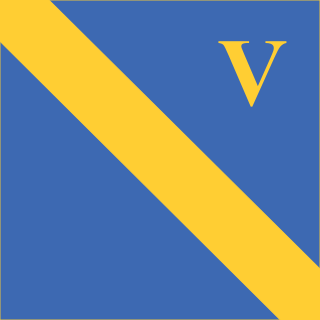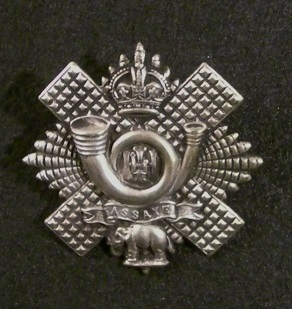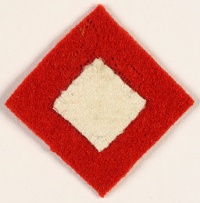
The 14th (Light) Division was an infantry division of the British Army, one of the Kitchener's Army divisions raised from volunteers by Lord Kitchener during the First World War. All of its infantry regiments were originally of the fast marching rifle or light infantry regiments, hence the title "Light". It fought on the Western Front for the duration of the First World War.
The division was disbanded by March 1919, and was not reformed in the Second World War.

The Manchester Regiment was a line infantry regiment of the British Army in existence from 1881 until 1958. The regiment was created during the 1881 Childers Reforms by the amalgamation of the 63rd Regiment of Foot and the 96th Regiment of Foot as the 1st and 2nd battalions; the 6th Royal Lancashire Militia became the 3rd (Reserve) and 4th battalions and the Volunteer battalions became the 5th, 6th, 7th, 8th, 9th and 10th battalions.

The 5th Infantry Division was a regular army infantry division of the British Army. It was established by Arthur Wellesley, 1st Duke of Wellington for service in the Peninsular War, as part of the Anglo-Portuguese Army, and was active for most of the period since, including the First World War and the Second World War and was disbanded soon after. The division was reformed in 1995 as an administrative division covering Wales and the English regions of West Midlands, East Midlands and East. Its headquarters were in Shrewsbury. It was disbanded on 1 April 2012.

The Lancashire Fusiliers was a line infantry regiment of the British Army that saw distinguished service through many years and wars, including the Second Boer War, the First and Second World Wars, and had many different titles throughout its 280 years of existence. In 1968 the regiment was amalgamated with the other regiments of the Fusilier Brigade – the Royal Northumberland Fusiliers, Royal Warwickshire Fusiliers and the Royal Fusiliers – to form the current Royal Regiment of Fusiliers.

The South Lancashire Regiment was a line infantry regiment of the British Army in existence from 1881 to 1958.

The Highland Light Infantry (HLI) was a light infantry regiment of the British Army formed in 1881. It took part in the First and Second World Wars, until it was amalgamated with the Royal Scots Fusiliers in 1959 to form the Royal Highland Fusiliers which later merged with the Royal Scots Borderers, the Black Watch, the Highlanders and the Argyll and Sutherland Highlanders to form the Royal Regiment of Scotland, becoming the 2nd Battalion of the new regiment.

The 42nd Armoured Division was an armoured division of the British Army raised during the Second World War.

The 42nd Infantry Brigade, also known as 42 Brigade, was a brigade of the British Army.
The 25th Infantry Brigade was a war-formed infantry brigade of the British Army that saw active service during both the First and the Second World Wars.

The King's Own Royal Regiment (Lancaster) was a line infantry regiment of the British Army. It served under various titles and fought in many wars and conflicts, including both the First and the Second World Wars, from 1680 to 1959. In 1959, the regiment was amalgamated with the Border Regiment to form the King's Own Royal Border Regiment.
The 25th Division was an infantry division of the British Army, raised as part of Lord Kitchener's Third New Army (K3) in September 1914, shortly after the outbreak of the Great War. It served on the Western Front for most of the war.

The 127th (Manchester) Brigade was an infantry brigade of the British Army that saw active service during both the First and Second World Wars. It was assigned to the 42nd Division and served in the Middle East and on the Western Front in the First World War.
The 164th Brigade was an infantry brigade of the British Army that saw active service in the First World War as part of the 55th Division. As the 164th Infantry Brigade, it remained in the United Kingdom throughout the Second World War, as part of the 55th Infantry Division.
203rd Infantry Brigade was a Home Defence formation of the British Army during the Second World War.
The 226th Infantry Brigade was a Home Service formation of the British Army that existed under various short-lived titles in both World War I and World War II.
221st Mixed Brigade was a Scottish Home Service formation of the British Army that served under various titles throughout World War I.
71st Division was a short-lived infantry division of the British Army during the First World War. It served in the Home Defence forces and never went overseas.

This is an order of battle listing the Allied and Ottoman forces involved in the Gallipoli campaign during 1915.
73rd Division was a short-lived infantry division of the British Army during World War I. It served in Home Forces and never went overseas.













